
views
Using Different Types of Quotes
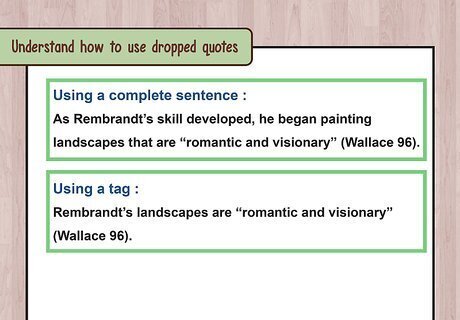
Understand how to use dropped quotes. Dropped quotes are partial phrases taken from the middle of a piece of text. Dropped quotes are comprised of only a few words and give no information about the speaker. These must always be introduced within a sentence, and cannot comprise a complete sentence on their own. Use a complete sentence to incorporate a dropped quote. Ex: As Rembrandt’s skill developed, he began painting landscapes that are “romantic and visionary” (Wallace 96). Use a short phrase to incorporate a dropped quote: Rembrandt’s landscapes are “romantic and visionary” (Wallace 96).

Understand how to use full sentence quotes. As the name implies, full sentence quotes are created by quoting complete sentences that take up less than 4 lines. Although these are complete sentences, they cannot be used as stand-alone sentences in your paper. Introduce them with an additional complete sentence or a signal phrase. Use a complete sentence to introduce a full sentence quote. Ex: Over the course of time Rembrandt’s work began to change and focus on different themes, but as Wallace points out: "Rembrandt’s great gift as an etcher lay in preserving a sense of spontaneity while scrupulously attending to close detail” (142). Use a signal phrase to introduce your full sentence quote. Ex: As Wallace states, “Rembrandt’s great gift as an etcher lay in preserving a sense of spontaneity while scrupulously attending to close detail” (142).
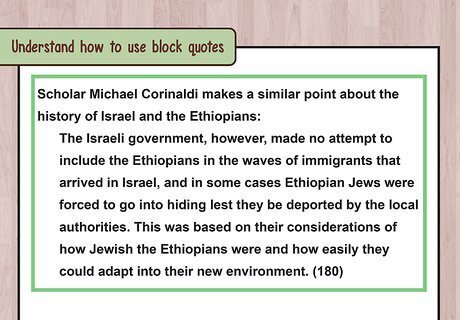
Understand how to use block quotes. Block quotes are multiple sentences quoted directly from a source which take up more than 4 lines in your paper, or no more than 3 if you are quoting verse. Because these take up a lot of physical space, they should be used sparingly with a maximum of 1-2 for a complete paper. Incorporate a block quote by adding a complete line space between your own content and the quote, and offsetting it by indenting the entire quote to the right a single time. Introduce your block quote with a colon. Ex: According to Wallace: (add a line break here, and then indent the entire quote). Block quotes do not use quotation marks. You have already stated who the author is/what is being referred to in the introduction sentence. Add the in-text parenthetical citation after the period at the end of the quote, though. If your block quote is inside a paragraph, you don’t have to start a new paragraph at the end of it. Simply add another line break and begin writing along the left margin (with no indent). However, you will need to indent the second paragraph by an extra 0.25 in (0.64 cm) if you are citing more than 1 paragraph.
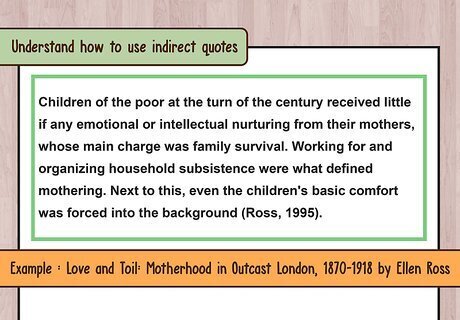
Understand how to use indirect quotes. Indirect quoting, or paraphrasing, is when you use a sentence from a source but change the wording slightly into your own words. This is useful when you cannot meet rubric requirements by quoting, or if you’ve quoted too much. Be careful to avoid plagiarism though by changing at least 50% of the sentence. Change the structure of the sentence by moving clauses around. Aim to change at least half of the sentence into a new structure, but also make sure that the grammar is correct and the meaning of the sentence is still clear. You can use a thesaurus to exchange words with synonyms. Paraphrasing should only be done if you are certain that you understand the content you are copying. If you are unclear as to the meaning of the quote, you won’t be able to put it adequately into your own words. When you write your paraphrase, don’t look at the quote. Keep the meaning in your head and create a new sentence to match.
Formatting Your Quotes

Know where to place commas and periods. When you’re placing a quote inside your essay, you’ll likely have to use a comma or period at the end. If you’re quoting without giving a citation (because your entire essay is about a single work, for example) commas and periods go inside the quotations marks. If you’ve included a parenthetical citation, the comma or period goes outside the quotation marks after the citation. To use a comma, you might structure the quote with in sentence like this: “Yogurt provides beneficial bacteria to your gut,” so it is good to include 1 serving per day in your diet. To use a period, you might structure the quote like this: “Carrots are a valuable source of vitamin A.”
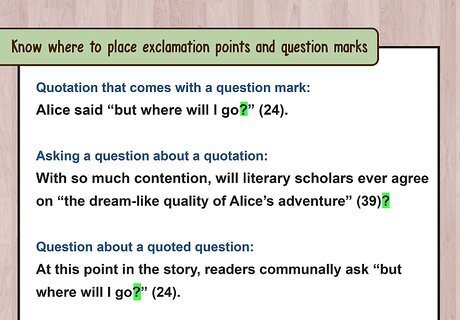
Know where to place exclamation points and question marks. If there is an exclamation point or question mark inside the quote you are using, keep it inside the quotation marks. If you’re asking a question or exclaiming the importance of a quote, add the punctuation outside of the quotation marks. If you are asking a question about a quoted question, use a single question mark inside the quotations. Example of a quotation that comes with a question mark: Alice said “but where will I go?” (24). Example of asking a question about a quotation: With so much contention, will literary scholars ever agree on “the dream-like quality of Alice’s adventure” (39)? Example of a question about a quoted question: At this point in the story, readers communally ask “but where will I go?” (24).
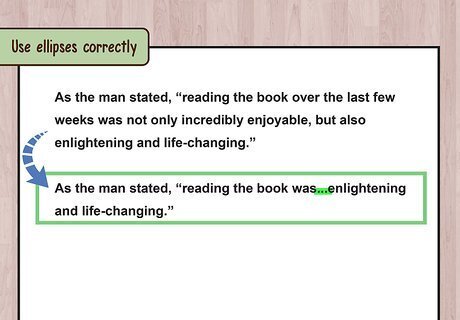
Use ellipses correctly. When you use the majority of, but not all of a quote, or if you begin in the middle of a quote, it is necessary to insert ellipses. These show that some of the sentence is not included in your quote. Use ‘...’ to show that a part of the quote before or after your selection has been excluded. Ellipses can be used in the center of a quote to leave out words that you feel add unnecessary length to the statement without adding value. For example: As the man stated, “reading the book was...enlightening and life-changing.” This is done rather than: As the man stated, “reading the book over the last few weeks was not only incredibly enjoyable, but also enlightening and life-changing.” Ellipses should be used only before or after a quote, not both. If you are only use a part of a quote from the center of a selection, it is just a partial or dropped quote. However, keep in mind that ellipses rarely come at the beginning of a quotation.
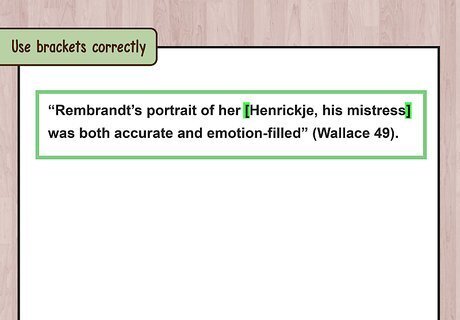
Use brackets correctly. The opposite of ellipses (used to leave something out), brackets are inserted into a quote to add information that you deem important/necessary but which is not included in the quote itself. You can include brackets in a quote to give a few words, typically the name of a person or place that the quote is focusing on, to help the reader understand the context. For example: As scholars have noted, “Rembrandt’s portrait of her [Henrickje, his mistress] was both accurate and emotion-filled” (Wallace 49).
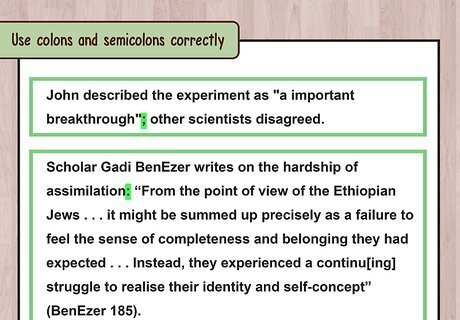
Use colons and semicolons correctly. If you are using a colon or semicolon after a quote, or there is a colon or semicolon at the end of your selection which you are quoting, place the punctuation mark outside of the quotation marks.
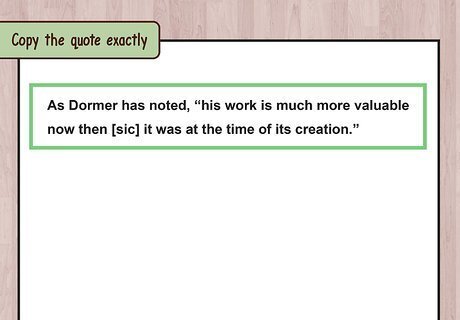
Copy the quote exactly. If you are using a direct quote, it is imperative that you copy it word-for-word. Include all spelling and grammatical mistakes as well, even if you are aware they are incorrect. If your quote has a mistake that you are aware of, put [sic] (italicized and in brackets) immediately after the mistake. This signifies that you are aware that there is a mistake in the quote, and that it is not a mistake on your part. Ex: As Dormer has noted, “his work is much more valuable now then [sic] it was at the time of its creation.”
Quoting in Different Styles
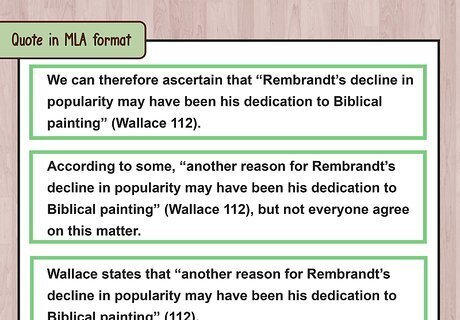
Quote in MLA format. When citing in MLA format, your in-text citation should include the author’s name and the page number that the information is from. You can include these together in a parenthetical citation, or you can mention one in your writing and the other in a parenthetical citation. Ex: We can therefore ascertain that “Rembrandt’s decline in popularity may have been his dedication to Biblical painting” (Wallace 112). Ex: According to some, “another reason for Rembrandt’s decline in popularity may have been his dedication to Biblical painting” (Wallace 112), but not everyone agree on this matter. Ex: Wallace states that “another reason for Rembrandt’s decline in popularity may have been his dedication to Biblical painting” (112).
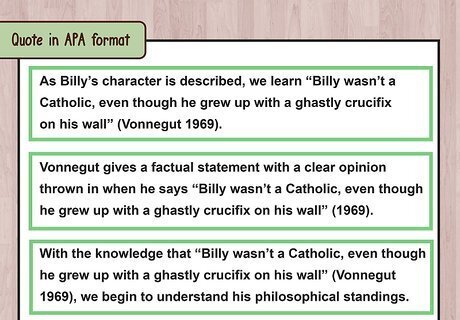
Quote in APA format. Slightly different than MLA format, APA requires an in-text parenthetical citation with the author’s last name and the year the text was published. They must be included together in the parentheses, or you can mention the name of the author in your writing and put just the year in parentheses afterwards. Ex: As Billy’s character is described, we learn “Billy wasn’t a Catholic, even though he grew up with a ghastly crucifix on his wall” (Vonnegut 1969). Ex: Vonnegut gives a factual statement with a clear opinion thrown in when he says “Billy wasn’t a Catholic, even though he grew up with a ghastly crucifix on his wall” (1969). Ex: With the knowledge that “Billy wasn’t a Catholic, even though he grew up with a ghastly crucifix on his wall” (Vonnegut 1969), we begin to understand his philosophical standings.

Quote in Chicago style. The Chicago style of formatting research essays uses footnotes at the bottom of your page rather than in-text parenthetical citations. In order to cite a quotation in your paper, add a footnote number immediately after the ending quotation mark (not inside the quotes). This should be paired with a matching citation at the bottom of the page.
Quoting Successfully
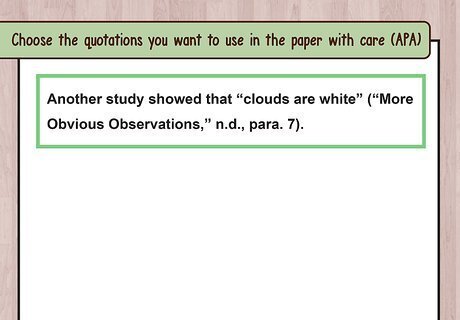
Choose the quotations you want to use in the paper with care. Overuse of quotations is considered sloppy in academic writing because it relies too heavily on others to make your point. Show not only that can you write, but that you can also judiciously sift through large amounts of research to glean the most important quotes that will support your argument.
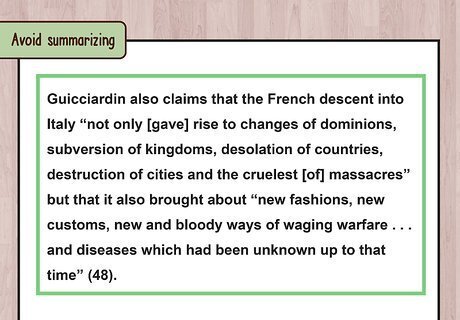
Avoid summarizing. If you’re quoting something directly, it should be done because you have valuable insights based on that particular phrase or set of information. Quotes should not be used as filler, followed by a long summary or paraphrase of what you copied. Make sure that when you discuss the quote, you aren’t simply repeating what the text says in different words.

Use quotes to highlight a specific phrase. Often times in academic writing, a very specific phrase or term may be used and described by an empirical source. If there is no way for your to better explain or reword this phrase, use a quotation. When possible, try to paraphrase or use an indirect quote to avoid seeming lazy with your writing.
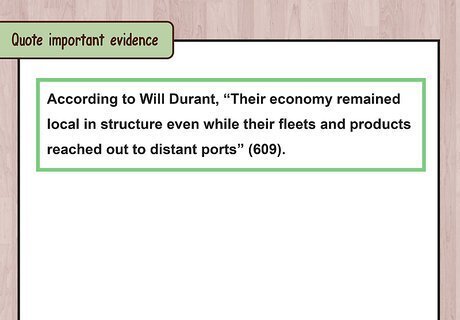
Quote important evidence. Quotations can be particularly helpful for an argumentative or study-based research paper, as you can use them to provide direct evidence for an important point you are making. Add oomph to your position by quoting someone who also backs it, with good reason. Be sure to elaborate on their point after quoting though, rather than just dropping it into your essay without further discussion.
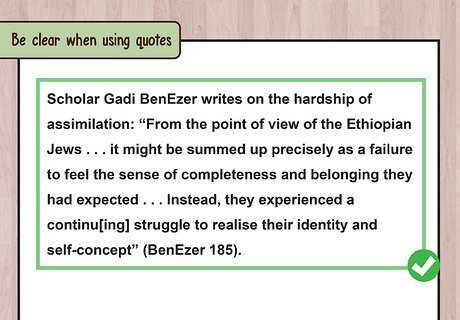
Be clear when using quotes. Although helpful at times, quotes that have not been clearly attributed can be confusing and out of place. Make sure your quote is given context before stating it. Although you should have a citation involved as well, it is important to make it clear to the reader that the ideas you are presenting are those of someone else.
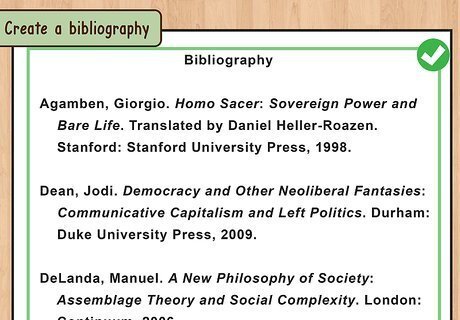
Include bibliographic information at the end of the paper. A "Works Cited" page, or other bibliographic source page, is used at the end of the paper to list full publishing information on each quoted source.



















Comments
0 comment